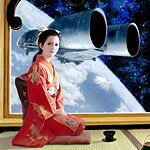

About Nippon 2007
About WorldCons
Agents
Art Show
Awards
Blogs/Galleries
Checklist
Child Care
Committee
Contact Us
Con Suite
Contests
Dealers Room
Donbura-con
Exhibits
Facilities / Maps
F A Q
Fanspeak
Filking (Music!)
Guests of Honor
Handicapped Services
Hotels
Hotel Alternatives
Hugo Awards
Hugo Winners
Hugo Nominees
Rocket Archive
Language/Food/Culture
Links
LiveJournal
Main Events:
Masquerade
Members
Mmbrshp Transfer
Newsletters (At Con)
Parties
Photos
Program - Western
Program Grid
Program Participants
Program - Japanese
Publications
Registration
Seals/Stickers
Seiun Awards
Site Map
Site Selection 2009
Speculative Japan
Tour with Fans
Ghibli Tour
Travel
Travel Links
Volunteers
World S F Society
Nippon Bid Site
Nippon2007.org
Archon 31 (NASFiC)
2008 Denvention 3
2009 Anticipation
![]()
![]()
How to visit Japan without Losing your Shirt
by Rachel Manija Brown
The first time I went to Japan, I didn't speak a word of Japanese or know anyone there. I went by myself, and I had the time of my life. Rachel Manija Brown is a writer in Los Angeles, author of All the Fishes Come Home to Roost, Rodale Books, 2005. Raised in India, she brings a unique perspective to traveling in Japan. We thank her for permission to reprint her LiveJournal post here. www.rachelmanijabrown.com. |
Apart from the plane tickets, I found Japan to be a pretty cheap country to visit; not cheap like India, but inexpensive for a first-world country. I'm sure it's very possible to spend your life savings in two days if that's what you really want to do, but if you don't require a lavish hotel or exclusive clubs, but merely want to eat good food and see the sights, I found Japanese cities to be cheaper to visit than comparable European or American cities that I've visited.
The Price Tag.
People I've spoken to who have never actually been there tend to obsess over two things: $200 melons, and unsuspectingly ordering a meal, only to find that it cost $1000. Let me explain those phenomena.a. The $200 melon. Yes, this is for real. No, it is not representative of the cost of groceries. That is a status symbol, used when you need to give someone a gift of a certain value. Kind of like giving your boss a Prada purse. You can't buy one by accident, because 1) they are clearly labeled, 2) the seller will see that you are a confused tourist and warn you.
b. "I walked into a bar and had two drinks, and now I owe the yakuza one meeelion dollars!" This urban legend is all over the place, and also appeared in a Lewis Shiner story in Wild Cards. This is not going to happen to you. Do you accidentally walk into exclusive gourmet restaurants where an appetizer costs $50 in your own country and eat an entire meal, thinking all the while that you're in a neighborhood joint? Well, you're not going to do that in Japan either. Excruciatingly expensive places look excruciatingly expensive; neighborhood joints look like neighborhood joints. Also, prices are typically listed on menus outside, and if not, they'll be listed inside. If you're really worried, ask.
Lodging.
The Welcome Inn Reservation Center is how you find an inexpensive hotel, and by that I mean between $35-$60/night. Why are they so cheap? Not because they're awful. There is a tourist-promotion operation going on which offers reduced rates. Also, Japan does not have a lot of violent crime, so cheap hotels cluster in unfashionable, out-of-the-way districts. If you don't mind ten extra minutes on the subway, you can stay in one of those for very cheap with no worries whatsoever. If you don't mind a shared bath, they will be even cheaper. Personally, I thought the shared hot baths were one of the highlights of my trips.
 The hotel room in my icon is Crossroads, a charming bed-and-breakfast in the heart of Kyoto. It cost about $40/night.
The hotel room in my icon is Crossroads, a charming bed-and-breakfast in the heart of Kyoto. It cost about $40/night.
There are various types of hotels, and differences from western hotel norms. Rates, for instance, are charged per person, not per room, so you will generally not save money by sharing a room.
Western-style beds may be narrow, and futons on the floor feel similar to mattresses. If you are tall or large, you may be better off with a futon. Also, pillows at Japanese-style hotels are sometimes filled with a substance that feels much like gravel. I recommend bringing a small pillow if you have not experienced this before and are not sure that you will like it.
Every meal I have ever had at a hotel which offered Japanese food was delicious. However, you do not get to pick from a menu, so be cautious of this option if you have food allergies or extensive food aversions. Otherwise, I find Japanese breakfasts (rice, pickles, miso soup, fish) to be particularly delicious, and hard to obtain outside of hotels.
Finally, hotels may be extremely hard to find, even with maps. As you will probably need to ask directions (possibly repeatedly), I recommend that you have your map, the name of the hotel, and Japanese for "Excuse me. Which way is [hotel]?" written down and in hand when you leave the train station.
Food.
Many restaurants do "set lunches." These will be posted outside, probably with plastic models. They are complete meals with a drink and several dishes, usually with two or three choices of meal, for about six to ten dollars. These are excellent value.Otherwise, look around. Go to neighborhood joints. Try new things. Places that look inexpensive will be inexpensive. If you don't know how to order something, point to the thing you want out of the plastic food in the window.
If you are daring, especially at a sushi restaurant, you may sit at the counter and say "Omakase." That means "chef's choice." You may want to establish a price range first. I've had some of the best meals of my life doing that.
Many restaurants only serve one thing: different types of eel (delicious!), or ramen, or sushi, or fried things on skewers. You will know what it is from the plastic food displays in the windows.
Generally, food is terrific. I have averaged one meal per trip that I didn't care for -- that's in three weeks of traveling.
Drink.
A lot of places only serve one brand of beer. Just say, "biiru."Yes, that is hot canned coffee in the vending machines -- wonderful on a chilly morning.
Transportation.
If you're not going to leave the Tokyo/Yokohama area, don't bother with a rail pass. If you're going to city-skip, you'll need one. They are expensive but necessary if you're planning to travel long distances.
The subways and trains are confusing, no way around it. Stops are announced, but it's still confusing. Get a subway and train map, and frequently ask for help.
Regarding gropers on the subways, I am sure that this is a genuine problem. I never encountered it, though. My guess is that like getting mugged in New York, if you live there it is likely to happen to you eventually, but it's no reason to avoid a visit.
Regarding people in white gloves shoving passengers into subways like sardines, this apparently exists, but I never saw it. I would recommend avoiding subways at rush hour, though, just because they're crowded and you may not be able to sit down.
Getting lost in Tokyo.
Tokyo is the most confusing city in the world. The streets have neither names nor numbers. The numbers on buildings are not sequential. You will get lost. Don't worry about it. It's part of the experience. Ask for directions frequently. Draw yourself maps.The little buildings on corners with cops sitting in them are koban-- police boxes. They exist to help lost people. Go in and ask for help. If the cop does not speak English, say, "[place] wa doko desu ka?" Try to get him to draw you a map. He will be happy to help you out.
Or ask strangers. They may not know where you are, but if they do, they will be sympathetic. At any given time, Tokyo has thousands of lost tourists wandering about in circles.
As a last resort, if you get really hopelessly lost, you may have to go to the nearest train or subway station and take it to a stop you're familiar with.
People.
I found that people were kinder to strangers in Japan than any other place I've ever been. If I merely stood on a corner and looked lost and hapless, someone would often stop to help out. This will work better if you are not Asian, as you are more obviously a tourist. Some Asian-American friends have mentioned that this didn't work as well for them, as people apparently thought they were Japanese and merely upset for personal reasons. If you want to make sure people understand the problem, take out a map and regard it in a frantic manner. That works even if you're Japanese-American.Books.
Bring your own. Books in English are double the cover price. There is an excellent used bookshop in Tokyo, but I'd have to walk you to it. (Good Time Books, outside of the JR Ebisu station.)Department stores. (Depaato)
Best. Things. Ever. Go inside. Head for the basement. That's the food place, where you will see the most amazing, delicious, and beautiful pastries and fish and fruit and whatever. With free samples!They are like Faerieland: don't go inside unless you're prepared to stumble out six hours later with no sense of that much time having passed.
Language.
At least learn how to say hello, goodbye, good morning, thank you, please, toilet, left, right, train, subway, and where is the...? Counting up to five is also good. (There are many counting systems, but the basic numbers will work for touristy purposes.)
The more you learn, the more you'll be able to communicate, though, and the more fun you'll have. "I like..." "I do not like..." are particularly useful constructions. You can have a whole conversation that way. Beautiful and interesting are also words you will use a lot.
Japan uses a lot of English loan words. You can sometimes make yourself understood by adding a vowel to the end of an English word and giving it a Japanese pronunciation. For instance, if you're trying to get someone to microwave the bun you're buying, "hotto" will get your point across.
Be polite. It's appreciated.